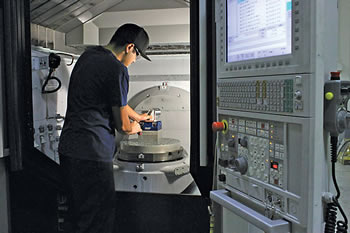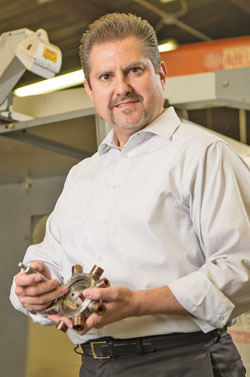From rolled steel to precision satellite instruments, companies in San Bernardino County, Calif., make products that require a constantly evolving educational system producing best-in-class workers.
No one knows this any better than Mark Mahboubi, president of R&B Machine LLC in Upland. A manufacturer of high-tech space communications devices that are installed on satellites, R&B uses “very high-precision machines that require highly experienced workers,” says Mahboubi, whose 40-person firm is experiencing a 270-percent increase in sales this year.
Established in 1997, R&B expects to hire up to 20 additional workers in 2015, says Mahboubi, adding, “We bring in very bright people.”
R&B relies on a variety of area institutions for equipping the company’s workforce. The National Tooling and Machine Association Training Centers of Southern California in Ontario, California State Polytechnic University in Pomona, and Harvey Mudd College in Claremont all produce graduates who go on to become trained technicians at R&B.
“The NTMA school provides 950 hours of training on specialized machines. We interview their graduates and hire the top one percent of their students,” says Mahboubi. “Cal-Poly is very strong in engineering; and Harvey Mudd is number one in the nation in average salary for its graduates. It is as good as MIT.”
That’s important, says Mahboubi, because the work R&B does has little to no margin for error. “The majority of the suspension system for the Mars Curiosity Rover was made right here,” he notes. “We developed the new tires for the Rover. We design the communications antennas that go on the satellites for Boeing. We make parts for the Joint Strike Fighter, the Boeing 787, the F-15 and the Airbus A320. We make parts for a pacemaker company in Ireland.”

Mahboubi says R&B could not do any of this work without access to the top talent in the world for working on machine tooling and precision instruments. “The labor market here in San Bernardino County is very large — around 1 million workers — and this gives us the ability to hire only the best of the best,” he adds.
Another benefit of R&B’s location in Upland is that “the county offers 50 percent of the salary of a new worker for up to three months of on-the-job training,” Mahboubi says. “The cost of doing business in Los Angeles County is enormous, but it is much better here. Our labor pool is huge, and this is known as a very business-friendly area. Plus, I can get to the Ontario International Airport in five minutes or to LAX in 40 minutes. We really have the best of both worlds right here in San Bernardino County.”
That is a refrain echoed by many executives at advanced manufacturing companies throughout the county. From the cities of Upland and San Bernardino in the valley to towns like Victorville and Adelanto in the High Desert, employers large and small say the overall business friendliness of the county — coupled with its highly competitive cost structure and logistics network — makes San Bernardino County the location of choice in Southern California.
What enables them to excel, however, is the workforce.
Talent: The Ultimate Trump Card
Dr. Shanling Yang, program management officer for Mooney International, says the world-renowned manufacturer of small aircraft selected Chino to be the firm’s global R&D headquarters because the San Bernardino County location offers access to “excellent resources of engineers in Southern California.”
Yang says Chino is a “preferential geographical location for network and connection to Asia,” — a key factor given that Mooney’s corporate parent is based in Beijing.
Space for expansion is also a plus, she notes. “Chino Airport and the city have much room for development and growth,” she says. “The airport is not landlocked, so Mooney has the ability to expand with not only airplane development and manufacturing, but also supplemental programs.”
Yang says the company’s goal is to establish a training facility in Chino for both pilots and mechanics. “Our global headquarters is in Beijing, our US headquarters is in Kerrville, Texas, and our R&D headquarters is here in Chino,” she adds. “This is the brain, the think tank, of new product development for Mooney.”
Founded by Al Mooney in Wichita, Kan., in 1929, the company today owns 132 world speed records, including the fastest transcontinental flight in a single-engine piston-powered production aircraft.
“We are taking on a lease of a new production facility at the Chino Airport,” Yang says. “We have a lot brewing in R&D. This year, you will see something new.”
R&B and Mooney have plenty of company in the rapidly growing aerospace sector in San Bernardino County. On the other side of the San Gabriel Mountains in the High Desert, Exquadrum Inc. is taking rocket science to new heights.
Based in Adelanto, a community of 31,000 people in the western portion of the county, Exquadrum — which is Latin for “outside the box” — is considered one of the leading innovators in space launch vehicle design, liquid engine technology development, and satellite thruster technology.

Eric Schmidt, president of Exquadrum, says that “first and foremost, we are inventors. We are asked by our customers to solve difficult problems with non-traditional solutions.”
With 23 employees at Adelanto and nearby Victorville, Exquadrum is outgrowing its space and is in need of a 40-acre parcel for expansion, notes Schmidt.
“We have unique siting needs,” Schmidt says. “We do work for NASA and the Department of Defense primarily. We also do work for large firms in the private aerospace industry — companies like Boeing, Raytheon and Lockheed Martin. California has always had a strong location stance in the aerospace industry, and in particular in this part of the Mojave Desert. A myriad of aerospace firsts have occurred here. Many of them have come out of Edwards Air Force Base, Palmdale-Lancaster and Antelope Valley.”
When asked why he selected Adelanto to be the home of Exquadrum, Schmidt replies that “we looked for locations with elements of open space but also very business-friendly permitting and regulatory environments. Plus, it was cost-effective with reasonably sized parcels of land. The amenities that any technology business needs — cost-effective land and buildings, along with all required infrastructure such as water, electricity and natural gas — are all here.”
It added up to a winning formula for Exquadrum, says Schmidt. “Adelanto provided all of the essential pieces, and frankly it has been a very good place for us to do business.”
For workers, Schmidt says that “we lean on local university talent that is about an hour away. Cal-Poly Pomona provides highly talented graduates. We have a very active engagement with the university engineering program via internships. Overall, I would say that Southern California provides a preferred labor pool for companies like ours engaged in aerospace.”
He adds that “we will expand with some new facilities this year. We have the ability to grow by 10 to 15 people in 2015. We need more office space, and we need larger catch facilities — large swaths of land to test rockets and perform other research.”
A Steely-Eyed Gaze to the Future
Aerospace firms aren’t the only manufacturers growing in the county. Makers of furniture and steel are expanding as well. Consider the case of United Furniture Industries Inc.
Four years ago, the East Okolona, Miss.-based furniture maker selected the Southern California Logistics Centre in Victorville for a 505,192-sq.-ft. manufacturing and logistics plant. Today, that plant employs 300 workers and is still growing.
“It is a good setting out there,” says Bob Cottam III, vice president of Piedmont Risk Management in High Point, N.C., the firm that handles site selection for UFI. “It is as nice a plant as you will see anywhere in the world. We will continue to add to the Victorville plant workforce as sales develop out there. We have talked about adding space at some point.”
Cottam notes that “within three hours of Victorville, you have 23 million people, so it is a very good location for reaching markets from the Mexican border at San Diego up to Ventura along the coast. We feel like we can get another $35 million to $50 million in business out of our plant in Victorville. We renewed our lease on the facility last year and plan to be there for a long time to come.”
Across the mountains in Fontana, the largest steel manufacturer on the West Coast continues to grow. California Steel Industries Inc. started with 300 employees in 1984 and is now up to 1,000 workers.
“We have put $1 billion in capital investment into this plant over the last 30 years,” says Brett Guge, executive vice president of finance and administration for CSI. “We produced over 1.7 million tons of steel last year, and we have a capacity for 3 million tons. We are proudest of the fact that we have never had a layoff in 30 years.”
The San Bernardino County location gives CSI great access to the Ports of Los Angeles and Long Beach, notes Guge. “About 95 percent of our incoming steel slabs come from the Ports of LA and Long Beach,” he says.
Through a unique partnership with Chaffey College in nearby Rancho Cucamonga, CSI is establishing a new on-site training facility that will equip the company’s future workforce. A $15-million federal grant administered through the US Department of Labor is funding the project.
The only such grant awarded in California, the money will pay for construction of a training center on CSI property. Slated to open on August 1, the facility will train workers in electrical, mechanical and electronic control jobs, as well as computer technicians, machinists and welders.
“A lot of talent lives here,” says Guge. “We are centrally located in the Inland Empire, and that affords the folks who live here access to a great quality of life. You can be surfing at the beach in one hour, or you can be snowboarding in the mountains in one hour.”
CSI recently expanded by adding a $100-million pipe mill that began taking orders in late 2014.
Area Colleges Provide Skilled Workers
Chaffey College, with 20,000 students, is one of the most important community colleges in Southern California. Critical to the workforce, Chaffey provides the kind of technical training that employers like CSI rely upon to keep up with ever-increasing demand for workplace skills.
Chaffey College is part of the Inland Empire Regional Training Consortium, a partnership among 10 community colleges serving the region. These schools also include Barstow College, College of the Desert, Crafton Hills College, Mt. San Jacinto College, MiraCosta College, Norco College, Riverside City College, San Bernardino Valley College and Victor Valley College. Also part of the consortium are CSU-San Bernardino and UC-Riverside.
The IERTC is a regionally coordinated, large-scale effort to develop the highly technical workforce necessary to advance industry in the area. Educational programs and certificates are aligned with the National Association of Manufacturers and the Institute for Manufacturing. Many employers in the region — including CSI, Ashley Furniture and Southern California Edison — participate in the partnership.
James Ramos, supervisor of the Third District and chairman of San Bernardino County government, says that “the countywide vision provides for cradle-to-career education and training. We believe in early intervention. It is part of our strategic plan.
“What sets our county apart is the fact that workforce training here is run by industry owners and managers. Our employers tell us what they need in a qualified workforce, and it is then our job to provide that. As a result, we now have the top Workforce Investment Board not only in California, but also in the entire country.”
This Investment Profile was prepared under the auspices of San Bernardino County government. For more information, contact Larry Vaupel, Economic Development Agency Administrator, at 909-387-9801 or by email at Larry.Vaupel@eda.sbcounty.gov. On the Web, go to www.sbcountyadvantage.com.
